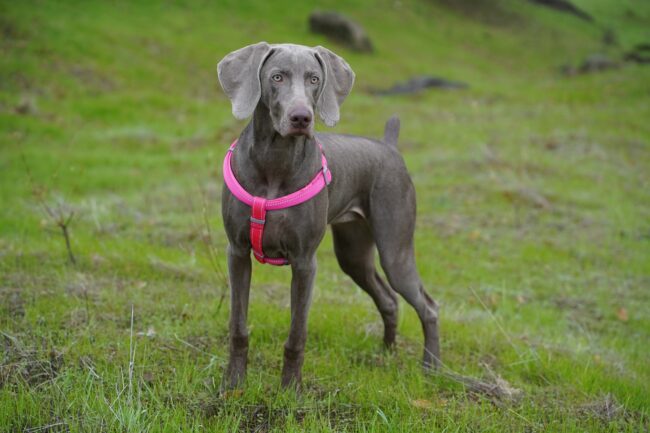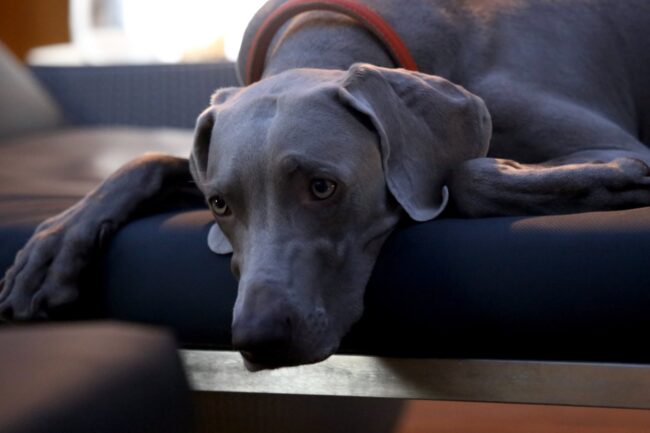Table of Contents
Known for its gentleness, the Great Dane has long been preferred by those looking for a large dog without the inconvenience and hostility that sometimes go hand-in-hand with other giant breeds. Indeed, the breed is playful, child-friendly, and affectionate with family.
Today, we look at a fascinating color variety within the breed – a lovely creature that turns heads everywhere. That’s right. We are, of course, referring to the stunning blue Great Dane.
What is a Blue Great Dane?
Great Danes come in a variety of colors such as black, blue, merle, mantle, brindle, and fawn, to mention but a few. Blue is the least common and the toughest to breed. Still, the blue Great Dane is highly admired and captures the attention of many dog lovers.
Their unique blue color is the result of breeding two dogs that each have a recessive blue gene in their DNA. When a puppy inherits both genes, one from each parent, it will be born with the sought-after blue coat.
However, genetics can be unpredictable, mostly because a dog’s color is not always solely dependent on a single gene. Hence, breeding two blue Great Danes won’t necessarily guarantee a litter of blue puppies or even a single blue puppy in a litter.
The Great Dane’s Temperament
Great Danes differ from their hunting ancestors. Traditionally, they were bred to hunt wild boars and also guard country estates. While the breed no longer needs to show aggression, they are still fearless and attentive.
Due to their fearless attitude, they are very cool-headed dogs. They do not bark a lot, which is a bonus if you want a pet with a quiet nature! The only problem is their large size. They can accidentally knock things over. Therefore, they require constant supervision and proper training from the beginning.
Does a Blue Coat Affect Its Temperament?
No, color has no influence on the temperament of a Great Dane. Each dog’s temperament will vary, based on how well it’s exercised, socialized, trained, and how well the owners treat it.
Personality Traits of a Blue Great Dane
As mentioned earlier, the Great Dane is considered to be a gentle giant. They are loyal, playful, affectionate, attentive, a good choice for novice owners, and kid-friendly. They usually get along with other dogs and animals, specifically if they grew up together. However, some blue Great Danes can be aggressive with strange dogs.
Blue Great Danes can be easy to train but according to some Great Dane fanciers, they can also be stubborn learners if they choose to be!
Is the Blue Great Dane a Dependable Breed?
Blue Great Danes are among the most dependable dogs for families and novice dog owners. They are loyal and trustworthy when it comes to young children. They know that they are ‘giant’ dogs and realize they have a duty to protect children from harm.
They are also intelligent enough to understand they can knock over a child with ease. If the kids are older than six, many parents allow them to play with a Blue Great Dane in the backyard. A majority of adult Great Dane owners believe they can depend on their dog to watch over their children.
It is not recommended to leave a Great Dane unsupervised with a toddler, even for a few seconds. Some giant dogs do not realize the extent of their power and may end up hurting the child unintentionally.
Living with Blue Great Danes
A Blue Great Dane must have ample room to move around and exercise, especially when it’s still young and energetic. You also need to stay aware that they eat a lot and this will be one of the biggest expenses that you can expect. It’s also prudent to provide basic obedience training for your dog, which will make handling such a large dog in an emergency a lot easier.
Are Blue Great Danes a Dangerous Breed?
Great Danes can be too big or strong for some people to handle but once again, obedience training helps a lot. Great Dane owners need not worry about this breed becoming aggressive or violent. Unlike their early hunter ancestors, Great Danes are very patient, and calm, and they aren’t easily aggravated. To sum it up, with proper training and breeding, Great Danes are not dangerous.
How to Socialize Blue Great Danes
When your Great Dane is young, introduce it to as many strange dogs and new people as possible. For example, a safe way to do this is to enroll your little one in a puppy school or organize a supervised play date with other dog owners. This will expose your Dane to new experiences and reduce fear-filled responses.
Exercising a Great Dane
It is vital that Great Danes get the right amount of exercise every day. This breed risk developing skeletal and hip problems due to its big size, hence, it is essential to maintain their fitness levels, the correct body weight, and a healthy diet.
Just enough exercise each day prevents them from gaining weight and their muscles from atrophying. All of these benefits help prevent serious health issues like dysplasia and hypothyroidism.
Usually, Great Danes prefer to relax, but owners shouldn’t encourage a sedentary lifestyle. A daily long walk or a quick jog does wonders for Great Danes.
Blue Great Dane Health and Care
The color of a Great Dane’s coat is known to affect the dog’s chances of developing congenital deafness. Particularly dogs with white or light brown colored coats are more susceptible to health issues than those with blue or darker coats.
Blue Great Danes are unlikely to suffer from congenital deafness but they may be genetically predisposed to other health conditions such as hip dysplasia, dilated cardiomyopathy, hypothyroidism, and bloat.
Life expectancy of a Blue Great Dane
Since this is a giant breed, unfortunately, Great Danes have a short life span, usually just six years. Six is considered to be the average, but some may live well past this mark.
Grooming and Feeding
Great Danes are born with a short and thin coat, so they do not shed hair. They only need to be groomed occasionally to remove dead hair. This also means they are not suitable for colder climates (unless they wear a warm vest).
Great Danes do not require a special diet, but it is always recommended that you feed high-quality food and treats. Preferably, opt for food that is specially formulated for large-breed dogs. This is because different-sized dogs have different nutrient requirements.
Final Thoughts
Blue Great Danes need the same love and care that you would need to give to any Great Dane. They require a well-balanced diet and regular exercise to stay healthy. If you are ready to dedicate your time to training and socializing with a dog, the Blue Great Dane may be the right fit for you.


